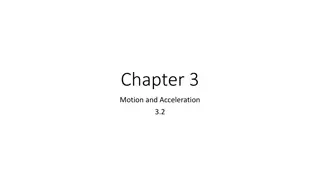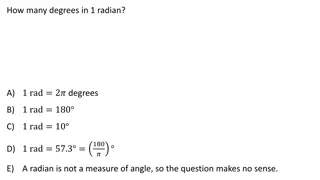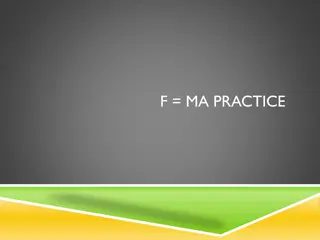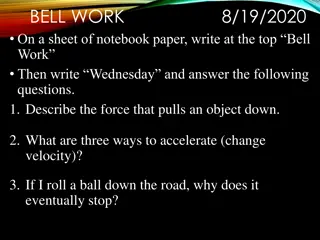Understanding Relative Velocity and Acceleration in Physics
Relative velocity is defined as the velocity of an object in the rest frame of another object, and it can be negative depending on the difference in velocities. The need for using relative velocity lies in determining if an object is at rest or moving. The formula for relative velocity involves the vector difference between the velocities of two bodies. The SI unit of relative velocity is Meter per second (m/s).
Download Presentation

Please find below an Image/Link to download the presentation.
The content on the website is provided AS IS for your information and personal use only. It may not be sold, licensed, or shared on other websites without obtaining consent from the author. Download presentation by click this link. If you encounter any issues during the download, it is possible that the publisher has removed the file from their server.
E N D
Presentation Transcript
RELATIVE VELOCITY AND ACCELERATION IN ONE AND TWO DIMENSIONS
RELATIVE VELOCITY Relative velocity is defined as the velocity of an object B in the rest frame of another object A. For example: A motorcycle travelling on the highway at a velocity of 120 km/h passes a car travelling at a velocity of 90 km/h.
Representation of relative velocity of two persons w.r.t stationary person
Representation of relative velocity of two cars in reference to x-axis
Can Relative velocity be negative? Relative velocity can be negative. As relative velocity is the difference between two velocities irrespective of the magnitude of the velocities, it can be negative.
What is difference between velocity and relative velocity? The difference between velocity and relative velocity is that velocity is measured with respect to a reference point which is relative to a different point. While relative velocity is measured in a frame where an object is either at rest or moving with respect to absolute frame.
What is the need of using relative velocity? The need for using relative velocity is that it is used for differentiating if the object is at rest or moving.
What is relative velocity formula? The relative velocity is the velocity that the body A would appear to an observer on the body B and vice versa. Mathematically, the relative velocity is the vector difference between the velocities of two bodies. i.e., Relative velocity = velocity of the body A velocity of the body B. The equation is: vAB= vA vB.
What is the SI unit of relative velocity? The SI unit of relative velocity is Meter per second(m? 1).
What is relative velocity example? We encounter occasions where one or more objects move in a frame which is non-stationary with respect to another observer. For example, a boat crosses a river that is flowing at some rate or an aeroplane encountering wind during its motion.
When relative velocity is zero? The relative velocity can be zero. It is absolutely possible because when two bodies move with equal velocity in the same direction, then they have zero relative velocity.
RELATIVE ACCELERATION Acceleration is the change in an object s velocity in a specific period of time. Relative acceleration is the comparison of the acceleration of two bodies or for a rigid body, the acceleration of a point on a rigid body in reference to another point on it.
Formula and Unit for relative acceleration The equation for relative acceleration is given by: ???= ???"+ ??"? The unit for relative acceleration is meter per squared second (m? 2).
RELATIVE VELOCITY AND ACCELERATION IN ONE DIMENSION Motion does not happen in isolation. If you re riding in a train moving at 10 m/s east, this velocity is measured relative to the ground on which you re traveling. However, if another train passes you at 15 m/s east, your velocity relative to this other train is different from your velocity relative to the ground. Your velocity relative to the other train is 5 m/s west.
Reference Frames To discuss relative motion in one or more dimensions, we first introduce the concept of reference frames. When we say an object has a certain velocity, we must state it has a velocity with respect to a given reference frame. In most examples we have examined this reference frame has been Earth. If you say a person is sitting in a train moving at 10 m/s east, then you imply the person on the train is moving relative to the surface of Earth at this velocity, and Earth is the reference frame. We can expand our view of the motion of the person on the train and say Earth is spinning in its orbit around the Sun. In this case, the solar system is the reference frame. In short, all discussion of relative motion must define the reference frames involved.
Relative Motion in One Dimension We introduce relative motion in one dimension first, because the velocity vectors simplify to having only two possible directions. Take the example of the person sitting in a train moving east. If we choose east as the positive direction and Earth as the reference frame, then we can write the velocity of the train with respect to the Earth as ??? = 10?/? ? east where the subscripts TE refer to train and Earth. Let s now say the person gets up out of /her seat and walks toward the back of the train at 2 m/s. This tells us she has a velocity relative to the reference frame of the train. Since the person is walking west, in the negative direction, we write her velocity with respect to the train as ???= 2m/s ?
Cont.. We can add the two velocity vectors to find the velocity of the person with respect to Earth. This relative velocity is written as ???= ???+ ??? When constructing the vector equation, the subscripts for the coupling reference frame appear consecutively on the inside. The subscripts on the left-hand side of the equation are the same as the two outside subscripts on the right-hand side of the equation. The subscripts for the coupling reference frame, which is the train, appear consecutively in the right- hand side of the equation.
Cont.. Adding the vectors, we find ???= 8?/? ? So the person is moving 8 m/s east with respect to Earth.
Velocity vectors of the train with respect to Earth, person with respect to the train, and person with respect to Earth.
Relative Velocity in Two Dimensions We can now apply these concepts to describing motion in two dimensions. Consider a particle P and reference frames S and S . The position of the origin of S as measured in S is ?? ?the position of P as measured in S S is ??? , and the position of P as measured in S is ???.
Representation of position of the particle
Cont.. From figure, we see that ???= ??? + ?? ?
Relative velocities The relative velocities are the time derivatives of the position vectors. Therefore, ???= ??? + ?? ? The velocity of a particle relative to S is equal to its velocity relative to S S plus the velocity of S S relative to S.
For number of reference frames We can extend it to any number of reference frames. For particle P with velocities ???, ???and ???in frames A, B, and C, ???= ???+ ???
Relative Acceleration We can also see how the accelerations are related as observed in two reference frames by differentiating ???= ??? + ?? ? We see that if the velocity of S S relative to S is a constant, then ?? ?= 0 and ???= ??? This says the acceleration of a particle is the same as measured by two observers moving at a constant velocity relative to each other.























